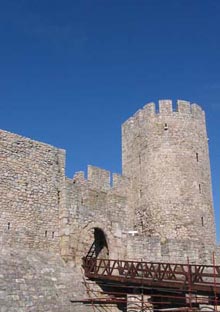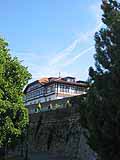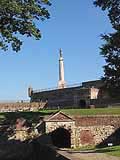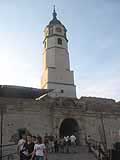Kalemegdan Belgrade Fort
 The oldest parts of Belgrade Fortress Kalemegdan date back to the first century AD, when it served as permanent Roman military camp.
The Belgrade fort itself (split into the Lower and Upper towns) and the surrounding area (the Kalemegdan park) are located on the
point where the river Sava flows into the Danube, which today means an amazing panorama but once was the main cause of repeated
invasion and war over this strategic point. Because of this, Kalemegdan today bears witness to the many centuries of various
conquering cultures and arts.
The oldest parts of Belgrade Fortress Kalemegdan date back to the first century AD, when it served as permanent Roman military camp.
The Belgrade fort itself (split into the Lower and Upper towns) and the surrounding area (the Kalemegdan park) are located on the
point where the river Sava flows into the Danube, which today means an amazing panorama but once was the main cause of repeated
invasion and war over this strategic point. Because of this, Kalemegdan today bears witness to the many centuries of various
conquering cultures and arts.
If you want to have a detailed tour of all there is to see on Kalemegdan, you should set out a whole day; however, if you're tight on time, it's still worth it to take an hour's stroll through the Kalemegdan park and over to the rivers. The easiest way to get there is to walk down Knez Mihajlova street from the beginning (from Terazije Square) to the end at Kalemegdan.
The first settlement was founded in the 3rd century BC - by the Celtic tribes. The old Celtic name was Singidunum. Later the Romans and IV legion of Flavius were settled in Belgrade and slowly the civil settlement started to develop just next to the fort. However, Singidunum was completely wiped out by Huns in year 441. Later the city was rebuilt by tsar Justinian who equipped Kalemegdan with strong walls (at that time, Kalemegan was part of the Byzantine empire). The Slavic name Belgrade was used for the first time in the 9th century.
Belgrade fell to Serbian hands during the rule of king Dragutin in the 13th century, but was mostly developed by Despot Stefan Lazarevic - who was also the founder of the Serbian capital. He created a strong economic, social and educational base in the city. Belgrade soon became the biggest Serbian settlement, and in the upper Kalemegdan fort Despot Stefan Lazarevic built a fort for himself. After his death Belgrade was again conquered by Austro-Hungarians and became one of the rare settlements able to prevent the further breakthrough of Turks to the north.
Belgrade managed to defend itself from Turkish invasion for the first time in 1440 and a second time in 1456, in the famous battle - the so called Antemurale Christianitatis or defense of Christianity in which Janos Hunyadi managed to defeat Sultan Mehmed II. Nevertheless, in 1521 the Turks managed to conquer Kalemegdan and the city of Belgrade and it remained in Turkish hands for 150 years after that.
In 1688, Belgrade fell into Austrian hands again for short time, but their conquest of 1717 allowed them to start developing the city. The styles changed and the look of the city shifted from oriental to Baroque. A new defense structure was implemented, and the current star-shaped form of the fort dates from that age. Kalemegdan fort was virtually unconquerable - unfortunately, according to a 1739 truce with the Ottoman Empire, Austria gave Belgrade up, and not wanting to leave their modern architectural secrets over to the Turks, they systematically destroyed the city on their way out. The last big surge of the castle took place in 1807 during the first Serbian uprising, while in 1867 the Turks finally surrendered and left the city to its Serbian leader Mihailo Obrenovic.
In its long and bloody history, Belgrade was destroyed over 40 times and this is visible in the current look of the castle. In some places you can see several layers of walls of different make, and those originate from vastly different historic periods.
If you want unforgettable sightseeing cruise, please visit the Belgrade River Cruise section.
If you want to rent a boat, please visit the Private Charters section.










































